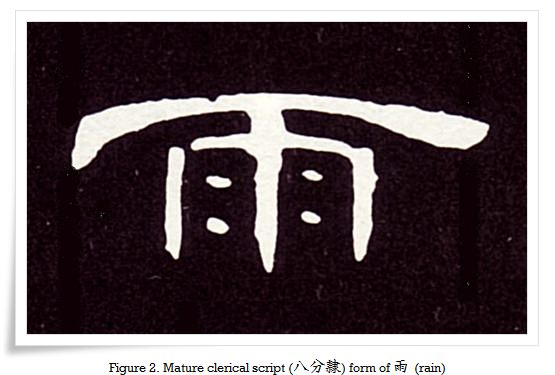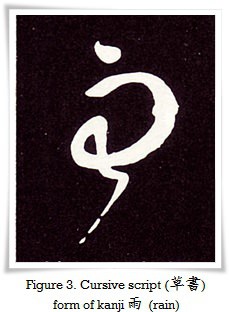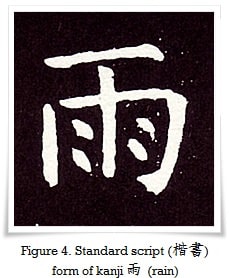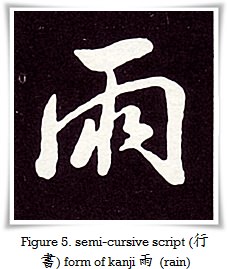1. Meaning:
rain
2. Readings:
- Kunyomi (訓読み): あま-、あめ、 -さめ
- Onyomi (音読み): ウ
- Japanese names: あめ, うらら, うるる, ふる
- Chinese reading: yǔ, yù
3. Etymology
雨 belongs to the 象形文字 (しょうけいもじ, shōkeimoji, i.e. set of characters of pictographic origin).
Kanji 雨 consist of three compounds that all add to its pictographic nature. The top part 一 represents the heavens (天,てん, ten), the 冂 (けい, kei) represents clouds (雲,くも, kumo), and the four dots represent the rain falling from among the clouds (Figure 4).
However, in some of the 金文 (きんぶん, kinbun, i.e. “text on metal”) and 卜文 (うらぶん, urabun, divinatory text, from c.a. 1600 B.C.) inscriptions, there are forms of 雨 that do not include either 一 or 冂. This would imply that more complex forms were added in time, to enrich the written texts (Figure 1).
雨 is one of the few characters, whose shape has not changed much for thousands of years.
4. Selected historical forms of 雨
Figure 1. Various forms of the character 雨 in Oracle bone script (甲骨文, こうこつぶん, kōkotsubun), c.a. 1600 B.C. – 800 B.C.
Figure 2. Tranquil and somewhat nostalgic shape of the character 雨 in mature Clerical script (八分隷, はっぷんれい, happunrei). It perfectly depicts the atmosphere and the mood of a rainy day.
Figure 3. Wild and dynamic form of the character 雨 executed in Cursive script (草書, そうしょ, sōsho). The energy and power of the storm slicing through the air with driving rain brilliantly caught in two simple strokes. Calligraphy by 王铎 (Chinese: Wáng Duó, 1592–1652) of the Ming dynasty(明朝, 1368 – 1644).
Figure 4. Ink rubbing of the character 雨 in Standard script (楷書, かいしょ, kaisho) taken from the stele in the Mausoleum of Confucius (孔子廟堂碑, Chinese: Kǒng Zǐ miào táng bēi), 7th century C.E.
Figure 5. Semi-cursive script (行書, ぎょうしょ, gyōsho) form of the kanji 雨. Calligraphy by 米黻 (Chinese: Mǐ Fú, 1051–1107) of the Song dynasty (宋朝, 960 – 1279).





